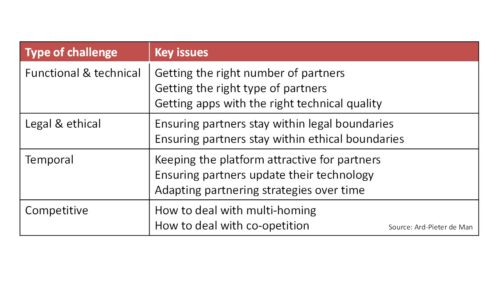Platform ecosystems (2): The four challenges of managing platform ecosystems
This is part two of seven blogs on platform ecosystems. All blogs can be found on Blogs – Organizational Revolution
The challenges of ecosystems
With the increase in the number of platforms, ecosystem management faces new challenges. The number of partners involved and the dynamics of a platform environment, raise new issues that require new answers. I identified four specific challenges in managing platform ecosystems that ecosystem managers need to address (for more an the role of ecosystem managers see https://bit.ly/3lmkuT5). The table below summarizes the four challenges and the key issues that have to be resolved.

Challenge 1: Functional & technical
The first challenge is functional and technical. Getting the right number of partners is easier said than done. Platform owners may face a chicken-and-egg problem: a platform requires customers to be interesting for vendors to engage on the platform, but without vendors, customers will not join the platform. When that problem is tackled the next question arises: how many partners is enough? With too few partners the platform is not attractive; too many partners may make the platform difficult to control. Next to the number of partners, the partner type is also relevant. Some platform may seek a highly diverse set of partners. On the big platforms you can find apps about any conceivable topic. Other platforms may choose to specialize in one area like games or fashion. Whatever choice you make, you will need to attract the right partner type for your platform. Finally, the partners need to have the right technical quality. An app that does not integrate seamlessly with the platform may chase customers away. Removing low quality apps is an important challenge connected to platform ecosystems.
Challenge 2: Legal & ethical
The second challenge relates to the behavior of partners. Once on board, they should remain within legal boundaries, but also respect the platform’s moral boundaries. Fake news, inappropriate videos or calls for illegal actions can undermine a platform’s legitimacy. Illegal or unethical behavior is not limited to individuals sharing malicious content on Facebook or Youtube. Ecosystem partners may also engage in undesirable activities. Curating the content and the ecosystem therefore also requires procedures to prevent misbehavior and to correct it when it occurs. But how to identify misbehavior among thousands of actors on your platform?
Challenge 3: Temporal
A third set of challenges presents itself around temporal problems. Platform ecosystems and their environment change over time. New technologies emerge, new players present themselves, incumbent players may lose out. The platform owner will have to keep up with the speed of change and keep the platform attractive for the ecosystem partners. This will often require the development of new technologies and standards. Such technical changes to the platform have consequences for the partners. When a technology is updated, apps also need to be updated to remain compatible with the latest technology. If apps developed by ecosystem partners are not updated, a platform may end up with outdated apps. That will ruin the customer experience. Finally partnering strategies need to be adapted to changing circumstances. Some partners may become more relevant, others less so. Such changes require a continuous rethink about how to engage with ecosystem partners.
Challenge 4: Competitive
The fourth and final challenge lies in dealing with competition on your platform. One aspect revolves around multi-homing. Multi-homing occurs when an app is available on several platforms. This reduces the opportunity for platforms to differentiate from their competitors. A second aspect revolves around co-opetition: at any point in time platform owners compete with their ecosystem partners over the way they share value. An example is Apple’s recent conflict with app developers that forced them to lower their commission rate from 30% to 15% for small partners (https://tcrn.ch/3litKaA). Ecosystem partners may even create their own competing platform or a certain app may become so popular that it forms a platform within a platform. Another form of co-opetition may occur when partners in the ecosystem compete with each other. Sometimes that works out well, sometimes it is less desirable. This mix of cooperation and competition is a characteristic of platform ecosystems (for more about different forms of co-opetition: see https://bit.ly/30LKgqg).
Are the challenges relevant for all platform ecosystems?
Yes, but the extent varies. An important variable to consider is the openness of the ecosystem. The more open an ecosystem is the more partners may join, but the less able you are to select partners based on competence or integrity. So you may attract a fair number of partners, but whether they are the right ones remains to be seen. In addition, the more partners on the platform the more difficult it becomes to monitor their behavior and their competitive moves. Obviously in some markets, some problems may be more relevant than in others. Highly specialized B2B markets may have higher technical challenges and lower ethical ones with their partners, whereas for twitter the reverse may be true.
How to deal with the challenges?
To deal with these challenges platform owners deploy various tactics. In the next episode of this blog series, I will give an overview of such tactics. But a good first step is to be aware of the challenges I mentioned: do they exist in your company? How do you deal with them now? Which challenge did you overlook? Do you dedicate sufficient resources to overcome the challenges?
About this series
In a series of seven blogs I give my view on the ins and outs of managing platform ecosystems. I will discuss the four challenges of managing platform ecosystems, what companies do to overcome the challenges, a model for the governance of platform ecosystems, modelling ecosystems through value maps, how value proposition based ecosystems relate to platform ecosystems and when to opt for a closed or open ecosystem.
All blogs can be found on Blogs – Organizational Revolution
